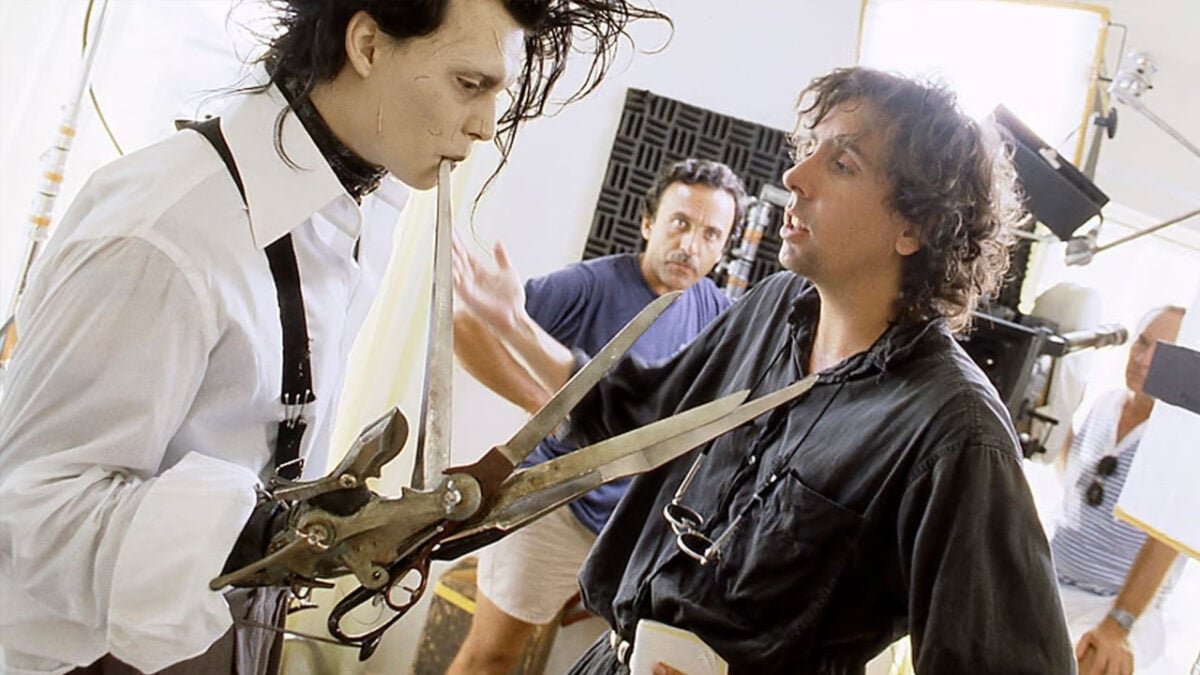Very few filmmakers leave a mark so distinctive it automatically signals to the audience that what they are about to see is a film unique to that director, perhaps a movie that only that filmmaker could make. One such artist is Tim Burton, the Disney animator turned auteur who has launched some of the most successful and visually distinctive movies in the past two decades.
So appropriately timed for the month of Halloween, CGMagazine’s Master Series salutes the Master of the Macabre, the Terror of Burbank, the man who wanted to grow up to be the guy that plays Godzilla: Tim Burton.
Part I: What if it all means something?
A number of things immediately set Tim Burton apart from other filmmakers; first and foremost is the gothic subtext he frequently brings to his vision. Look at his filmography, and you’ll see a man whose visual appeal is for the darker, gloomier side of life: a grey skies, “glass is half empty”, kind of worldview. This gothic vision spans many types and permutations, whether it’s Victorian in Sleepy Hollow, Germanic in the first Batman film, or Southern American like Big Fish. He’s also noted for his reverence towards German Expressionism, as seen in 1920s silent movies by Fritz Lang and F.W. Murnau.

Burton does a great deal of conceptual artwork for his movies; many of those drawings can frequently be seen in accompanying “Making of” books about Burton films. His drawing style has been compared to the illustrations of Edward Gorey with his use of pen and ink. Beyond visuals, common themes unite Burton movies; the main character is usually a well-meaning outsider whose reality shocks and perplexes the so-called normal people around him.
Furthermore, his movies take place in hyper-realistic worlds and frequently reference the struggle of two opposing forces trying to exist in the same space. This can take the former of a thematic confrontation turned real, like the states of life and death in Beetlejuice and Corpse Bride, or it could be an internal conflict inside a character, whether it’s the man-child Pee-Wee Herman, the animal-based personas of the characters in Batman Returns or the rulers of The Planet of the Apes.
Burton includes a number of recurring visual cues in his films, including the use of black-and-white stripes and checkers in costume and set design, as well as jack ‘o lanterns, scarecrows, redheads and twisting tress. Helping Burton create a uniform feel between vastly different films is his choice to collaborate with many of the same background artists and actors from film to film; most famously, they include composer Danny Elfman and actor Johnny Depp. The one other thing that the works of Tim Burton have in common is that they never fail to amaze or dazzle us with the breadth of their imaginative scope.
Part II: That Weird Kid
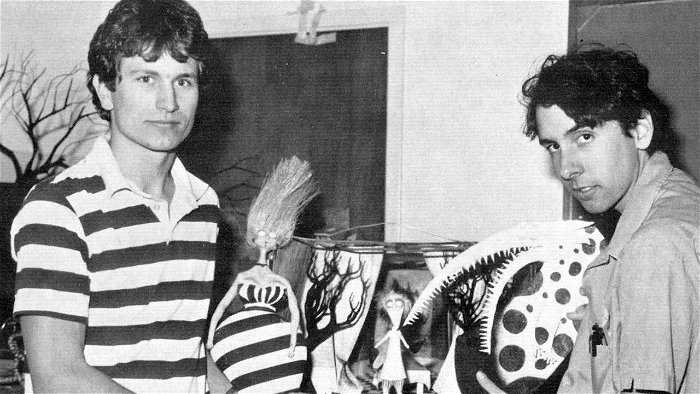
Burton grew up in Burbank, CA, a suburb of Los Angeles and was the first of two kids born to Bill and Jean Burton. All-in-all, he was a relatively well-adjusted kid, but the stark blandness of life in Burbank made young Tim turn to the accelerated fantasy worlds of the cinema, particularly horror movies. By the age of ten, Burton was glued to Saturday afternoon matinees and late-night shows on the TV watching the vintage Universal monster movies and the slick US imports from Britain’s Hammer Studios. He also enjoyed Roger Corman productions that starred the ubiquitous Vincent Price in films based on the stories of Edgar Allen Poe, like The House of Usher and The Raven.
In high school, Burton began to make his own films on 16 mm with friends, but hints of the existence of the introverted artiste within were hard to see, as Burton was also a successful athlete on the water polo and swim teams. He did get some attention for his artistic talents though; he won a contest to design an anti-littering campaign poster which appeared on garbage trucks around Burbank. Eventually, Burton won a scholarship to the California Institute of Technology where he would study animation in the Disney-sponsored Character Animation School.
Part III: Too Cool For School
At C.I.T., Burton even stood out amongst the heady crowd of aspiring animators including future Pixar chief and Toy Story director John Lasseter. Burton quickly grew frustrated with the constraints of traditional cel animation formulas and yearned to do something different and unexpected. In his third year, Burton got his chance when he developed a short black-and-white film called Stalk of the Celery Monster, about a sadistic doctor. The film caught the attention of Disney recruiters and in 1979; a 21-year-old Tim Burton had a one-way ticket to the House of Mouse.
Part IV: The Nightmare Before Pee Wee

Burton eagerly went to work at Disney, looking forward to bringing his far-out visions to life at the biggest animation house in Hollywood, but first, Burton did some uncredited design work for Ralph Bakshi’s animated adaptation of The Lord of the Rings. His first Disney assignment was working on The Fox and the Hound, whose cutesy talking animals did not exactly suit the tastes of the young animator. Burton had higher hopes for the follow-up, The Black Cauldron, but here again, Burton was met with disappointment as the Disney brass, again, refused his designs.
Despondent, Burton once again started developing his own homemade movies like Doctor of Doom and Luau, which was about a disembodied alien head in a surfing contest. Sensing frustration, Disney funded Burton to do a six-minute, stop-motion animation short called Vincent, about a young boy that idolized Vincent Price; Price himself even provided the narration for the film. Vincent made the rounds on the film festival circuit, but ultimately nobody at Disney knew what to do with it, so into the vault it went.
Burton was given further directing jobs on two other shorts: a Japanese-themed version of Hansel and Gretel and the live-action Frankenweenie, about a boy who brings his dog back to life in a manner befitting James Whale. Like Vincent, both of these shorts went nowhere fast, leaving Burton as dejected as ever. He even had a chance to direct After Hours but voluntarily bowed out when the film’s original director, Marin Scorsese, returned to the project after funding for The Last Temptation of Christ fell through. Little did Burton know, though that his big break was about to come after all.
Part V: “Betel Guise”

One person that was impressed by the Burton vision on display in Frankenweenie was comedian Paul Reubens, who insisted that Burton be the one to direct the big-screen adventure of his stage character Pee-Wee Herman. Pee-Wee’s Big Adventure came out in 1985 and although it was Reubens’ show the movie had distinctive Burton touches, including the first of a number of collaborations with composer Danny Elfman, lead singer of new wave band Oingo Boingo.
The success of Pee-Wee’s Big Adventure opened a lot of doors for Burton, but he took his time seeking a new project. He set up an office at the Warner Bros. lot and began to go through scripts for going on two years until he came across one that he could really sink his teeth into— Beetlejuice. The thing of it was that nearly everyone in Hollywood had refused to have anything to do with Beetlejuice, so Burton faced an uphill battle trying to recruit people to come onboard. Somehow though he’d convinced Alec Baldwin and Geena Davis to star as a married couple that find themselves dead only to return as ghosts and forced to evict a stockbroker (Jeffrey Jones) and an eccentric artist (Catherine O’Hara) from their home. Michael Keaton took on the title role of the manic ghoul and self-made human exorcist.
Made on a relatively cheap budget, Beetlejuice didn’t fail to impress with its blend of stop-motion animation and optical effects; it was even rewarded with an Oscar for Best Makeup. But what people especially enjoyed about Beetlejuice was its hilarious take on the afterlife. Inspired by Jean-Paul Sartre’s existential novel Les jeux sont faits, Burton portrayed the world beyond death as a meaningless bureaucracy filled with rules and paperwork and take-a-number efficiency. The Showtime series Dead Like Me would later take the idea to a new level by portraying a nine-to-five world where grim reapers punch a clock while collecting souls.

Most importantly though, Beetlejuice was a test for Burton, the passing of which allowed him to make the film he built his reputation on—Batman.
Part VI: Dark Knight and Darker Nights
For the better part of a decade, producers Michael E. Uslan and Benjamin Melniker had tried to get an all-new, darker and more serious Batman movie on the big screen and hit nothing but roadblocks. Then as Burton slaved on Beetlejuice, he was offered the opportunity to start working on Batman as his next project. Once Beetlejuice proved to be a commercial and critical success, Batman started moving full speed ahead as Burton and the producers were forced to take on one problem after another.
First there was the script, which had bounced back and forth between vastly different styles and tones with every new draft; Burton hired Sam Hamm to take charge of the script while he pursued casting and designing issues. For budgetary reasons, the film’s production was moved to Pinewood Studios outside London where a massive Gotham City streetscape was constructed, the design of which was directly influenced by Fritz Lang’s Metropolis.
Burton then went to work on choosing the cast of actors that were going to bring the characters to life. He immediately raised eyebrows by casting Jack Nicholson as the villainous Joker; Burton’s hope by hiring someone of Nicholson’s caliber was to bring an aura of respectability to what many thought of as a “funny book movie.” But the biggest shocker of all came when Burton cast Michael Keaton as Batman; the reaction to the news was so visceral that the story even appeared on the front page of the Wall Street Journal. The fear amongst Bat-fans was that by casting a man well known for comedic roles like Mr. Mom, Burton was making a declaration of intent to film a 60s style, campy Batman picture.
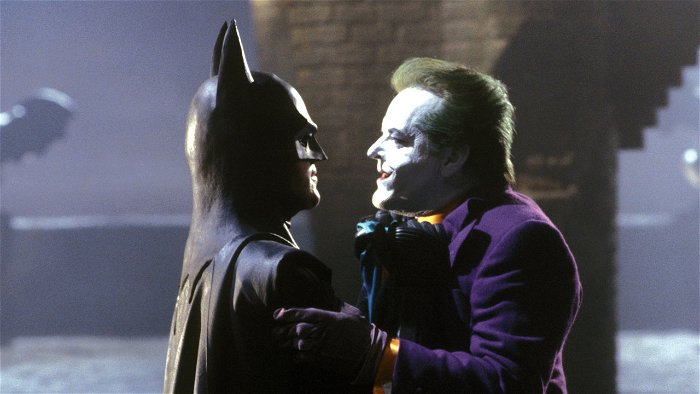
Burton had little time to worry about fan reaction though as the daily on-set grind of filming a massive production like Batman took its toll, and not helping matters was a back and forth battle of creative differences between Burton and producer Jon Peters. Launching the PR offensive in early 1989, Burton fought back against his critics by releasing a two-minute trailer that instantly reassured a nervous public.
In the days before QuickTime, fans went to the movie theatre for the sole purpose of seeing the trailer. By the time the movie was released on June 23rd, 1989, a merchandising frenzy had engulfed the nation, and excited fans finally got to see the real Dark Knight. Burton’s vision was vindicated to the tune of $250 million at the box office. San Francisco film critic Erik Preminger famously called it “The movie of the decade.”
With success like that, the talk immediately turned to sequels, and Warner Bros was anxious to retain Burton for part two. Burton, however, was unsure, decidedly split over whether or not to return to Gotham for another Batman adventure. Eventually, the studio sweetened the pot by giving Burton full creative control over the picture with the sole caveat being that the villain had to be the Penguin. The Penguin, as played by Danny DeVito was indeed in the soon-to-be-named Batman Returns and was joined by Michelle Pfeiffer as Catwoman, Christopher Walken as a new character called Max Shrek (after the actor in F.W. Murnau’s Nosferatu) and Michael Keaton once again donning the cape and cowl.
In Batman Returns, Burton tweaks the Penguin’s origin to make the criminal mastermind the horrible deformed son of wealthy aristocrats who send their son down the sewer when they can’t deal, only to have him raised by homicidal circus folk. Catwoman, who was never much more than a cat burglar in the comics saw her gaining supernatural powers after seemingly being killed by the odious Mr. Shrek.
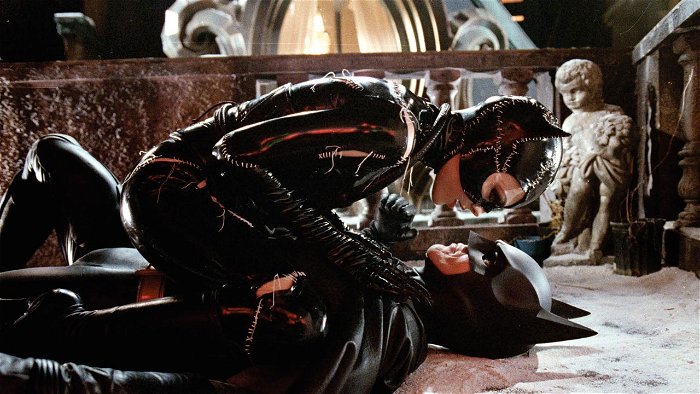
Suffice it to say that Batman Returns was more of a Tim Burton movie than a Batman movie, and taken from the point of view of the former, it is a wonder to behold. Burton’s gothic sensibilities become a living, breathing entity in this version of Gotham; the contrasting black and white of the main characters with the vibrant colours of the circus gang characters is a beautiful sight. One critic said that the film looked like it was done in an ink well, which to the mind of someone with the proper appreciation for the design of the film will take as a compliment. Other critics were not as kind though as parents and consumer groups felt that the film’s violence and frightening imagery had gone too far.
But with the reduced returns and higher budget, Batman Returns became Burton’s final Batman movie. Although he had initial meetings with the Warner’s brass to discuss part three, it really came to nothing because the meeting was more of a courtesy than an offer. Burton stayed on to produce Batman Forever, but for all intents and purposes, his association with Batman had ended.
Part VII: Edward
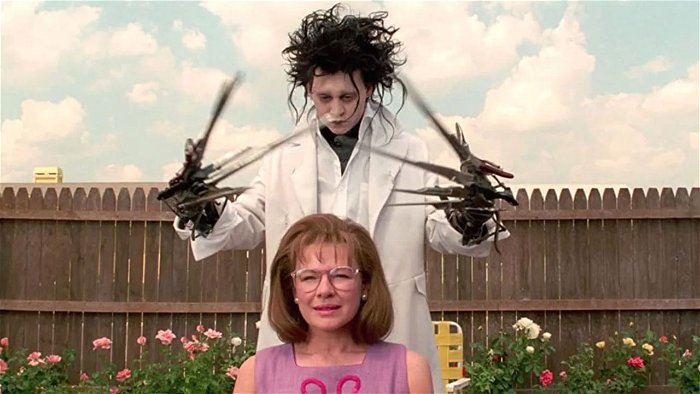
Between the Batmans, Burton decided to pursue a more personal project, the story of an uncommonly gentle man: Edward Scissorhands. Borrowing not only from his own life experience growing up in Burbank, Burton reached back to literary fables from Frankenstein to Beauty and the Beast to the Phantom of the Opera in order to draw inspiration for his very personal creation.
Edward, played by Johnny Depp in the first of many collaborations between him and Burton, is the creation of a loving inventor (played by Vincent Price in his final role) that dies before he completes Edward. As a result, Edward is left with several long metal talons for hands and fingers and he’s left alone in a vast castle on a hill overlooking a quiet suburban community.
Edward is brought home by the well-meaning Avon lady, Mrs. Bogg (Diane Weist), and while he’s an initial hit with the neighbourhood, the simplistic suburbanites soon become afraid of him. While living with the Boggs, Edward falls in love with Kim (Winona Ryder), and although she’s frightened of Edward at first, she soon grows to love him too. The growing animosity of the townspeople forces Edward back to the seclusion of the inventor’s castle where he and Kim go their separate ways forever. The story is book ended by an elderly Kim telling her granddaughter why it snows and closes with a shot of Edward carving a giant ice sculpture of Kim.
What has made the film so endearing over the years is the fact that the themes and characters of Edward Scissorhands work on so many levels. Primarily, it’s a tale of adolescent feelings of isolation with Edward and his wild black hair, pleather body suit and a face scared by the fact of his nature, subbing for the typical alienated teenager generally and Burton’s tormented youth specifically.
The scissor hands became a metaphor for the inability to express and receive love; at one point Kim asks Edward to hold her, to which Edward quietly and sadly responds, “I can’t.” It’s a moment in the whole that reminds us of just how difficult it is for all of us to express what’s inside. Perhaps for this reason, Edward Scissorhands continues to resonate with youth and the disenfranchised everywhere.
Part VIII: Jack, Ed and the Martians
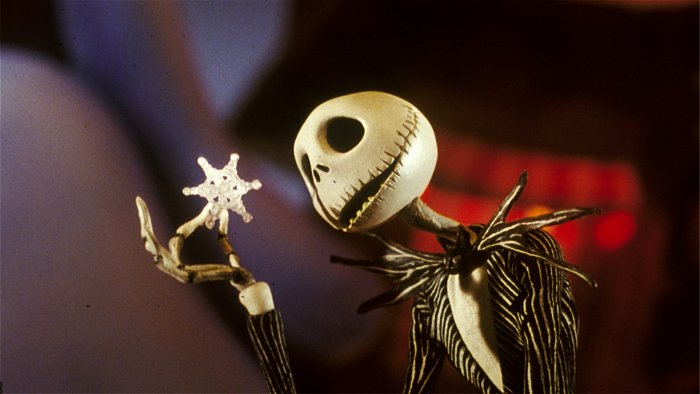
Edward Scissorhands and Batman Returns represented a shift in Burton tactics; he no longer waited for the right script, he started to become more proactive in making his own movies happen and soon old friends came calling. Disney was now anxious to work with Burton on an animated project, so the filmmaker reached into his past and brought to Disney an idea they’d refused the decade before. Burton had written and illustrated a poem about a young ghoul named Jack Skellington, who sets out to celebrate Christmas only to accidentally destroy it.
Inspired by a store display window that was being changed over from Halloween to Christmas, Burton came up with the idea to do a stop-motion animated film that paid tribute to his love of classic Christmas specials like How the Grinch Stole Christmas and Rudolph the Red Nosed Reindeer. He called the idea The Nightmare Before Christmas and when he took it to Disney execs in the 80s, they thought that the film would be too dark and opted against making it. But Burton kept his sketches and artwork for the day he’d have the clout to get Nightmare made; look closely in Beetlejuice and you’ll see Jack adorning the ghost’s hat during the climax. Due to scheduling conflicts, Burton couldn’t direct the film himself and passed helming duties over to Henry Selick, while he focused on story and character design.
Although not as initially lucrative as its Disney contemporaries like Aladdin and Beauty and the Beast, in the years since its release Nightmare has gained a substantial cult following. The film was especially embraced by goth culture and is currently viewed as a holiday classic in its own right. The characters from Nightmare have since appeared on all sorts of merchandise from toques to lunch boxes and even appeared in Disney’s Kingdom Hearts video game. Danny Elfman’s original music earned wide praise, but creative differences between Elfman and Burton led to a falling out, making Elfman unavailable to score Burton’s next film: Ed Wood.
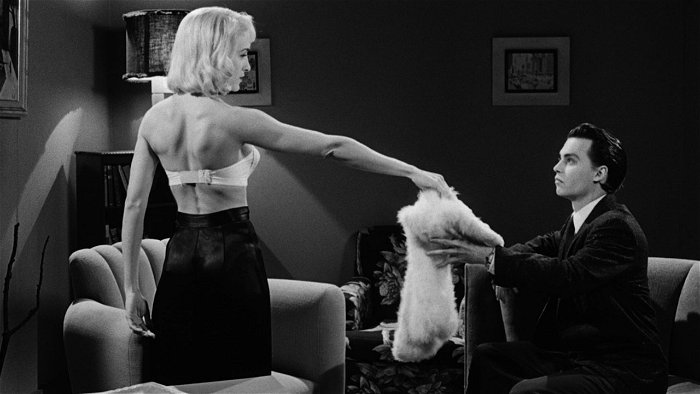
For his next live action project, Burton chose to do a tribute to the life of B-movie master Edward D. Wood Jr., the man who directed Plan 9 From Outer Space, widely regarded as the worst film ever made. Originally, Burton intended to make the Jekyll & Hyde movie Mary Reilly, but that project fell apart due to artistic and administrative problems. The script for Ed Wood was written in a relatively short period of time and was ready to roll before the cameras when creative differences between Burton and the studio, Columbia, over Burton’s decision to shoot the movie in black-and-white, forced the director to seek new backing.
At Disney, Burton was allowed to make the movie his way; preserving the sense of the 50s era through the use of black-and-white photography and by taking a sympathetic and respectful approach to Wood and his crew, who Burton had felt had been unfairly ridiculed through most of their lives. Burton’s loving tribute to Wood resulted in his biggest critical success to date, but it was a box office failure nonetheless. The film did garner an Oscar for Martin Landau for his performance as Bela Lugosi; the relationship between Wood and Lugosi has often been compared to the friendship shared between Burton and his own idol Vincent Price.
Bolstered by the critical esteem of Ed Wood, Burton moved full steam ahead into his next film, the alien invasion satire Mars Attacks! Based on the gruesome Topps trading card series from the 1960s, Burton recruited an all-star cast including Jack Nicholson, Danny DeVito, Glenn Close, Annette Bening, Tom Jones and several hundred little green, and extremely homicidal, men. Burton originally planned to do the Martians in stop motion a la the Skeletons in Jason and the Argonauts, but effects artists at Industrial Light & Magic convinced him to go with modern CGI over the old school approach. When released in December 1996, Mars Attacks! was a critical and commercial flop; but like The Nightmare Before Christmas, Mars has gained in appreciation over the past decade.
Part IX: Superman Aborted

In the face of his first true failure, Burton quickly sought new material to put him back on top. As luck and timing would have it, Warner Bros. was looking to re-energize the Superman franchise, and given Burton’s past experience with Batman, he was the logical choice to take on the Man of Steel. Producer Jon Peters had already approached Clerks director and comic fan Kevin Smith to write two drafts of a script based on The Death of Superman storyline from the comic books. But when Burton came on however, he jettisoned the Smith drafts and started from scratch; rumour is that this started a bit of resentment between the two filmmakers as Smith remarked that Burton didn’t even do him the courtesy of a meeting.
While Burton had screenwriters start on a draft, he began putting together a team of artists to draw out his vision of Superman’s universe, first hiring old friend Rick Heinrichs as production designer. Nicolas Cage then came aboard as Superman/Clark Kent, signing a lucrative pay-or-play deal that meant the actor would receive $20 million whether the movie was made or not.
Everything seemed to be going well for the project now titled Superman Lives, teaser posters bearing a silver S-shield and the release date of July 1998 were designed and ready to print, but a new frugal atmosphere at Warners’ in the wake of so many costly bombs meant that all big-budget projects were being given the comb over before being greenlighted. Burton and studio chiefs began clashing over everything from budget to merchandising as execs anxious to spread costs around demanded Burton work with toy designers. By the time July ’98 had actually rolled around, the offices that house production on Superman Lives were quietly shut down.

It wasn’t all doom and gloom for Burton during this time though. He returned to his roots by writing and illustrating a book called The Melancholy Death of Oyster Boy and other Stories. The very Burton-esque tome featured numerous unusual characters and stories; like “Stick Boy and Match Girl in Love”, “Robot Boy”, “The Pin Cushion Queen” and “The Boy with Nails in His Eyes”. Melancholy was well received by fans who loved the vintage, gothic Burton.
To everyone’s delight this was the sign of a trend as Burton retuned to film in 1999 with an adaptation of the Washington Irving tale of the Headless Horseman called Sleepy Hollow. Surrounding himself with familiar faces like Johnny Depp, Jeffrey Jones, Christopher Walken and a great many of the artists he’d gathered for Superman, Burton brought Sleepy Hollow to life in a manner befitting and honouring the tradition set down by Britain’s Hammer Studios. Hammer veteran Christopher Lee even appeared in a cameo as a judge that sends Ichabod Crane on a journey up the river Hudson to solve a string of unsolved murders in the titular hamlet.
Thanks to its dark, gothic sets, great performances and some chilly, creepy effects, Sleepy Hollow became Burton’s biggest commercial success since Batman Returns. Many of the same critics that egged Mars Attacks! welcomed the return to form of the filmmaker and helped bolster the film’s success despite opening the same weekend as the then latest James Bond picture, The World is Not Enough.
Part X: The Long Plateau
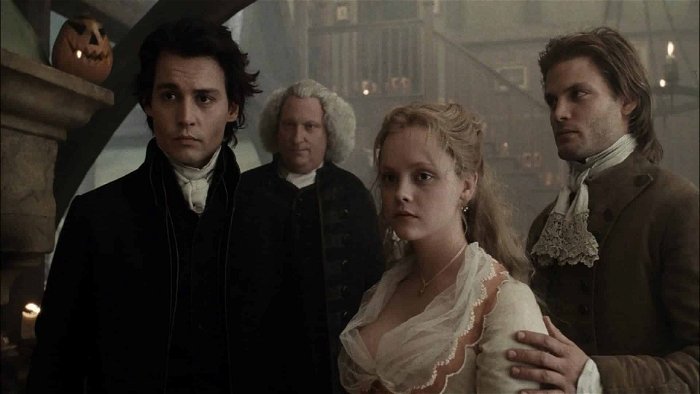
Burton wasted no time in capitalizing on the success of Sleepy Hollow as he signed up to reimagine the classic sci-fi film The Planet of the Apes. Working under a tight schedule through the winter and spring of 2001 to meet a set-in-stone summer release date, Burton crafted a new and original take on the story while including winks and nods to the 1968 original, complete with Charlton Heston cameo as an ape—naturally.
The film opened strong, earning $68 million US in its first three days, but critical lashings didn’t give the new Apes movie much of a leg to stand on. Many complained about the new ending that found Mark Wahlberg’s astronaut returning to an Earth ruled by apes, but the fact of the matter is that this movie’s ending is actually closer to that of the original book by Pierre Boulle. Burton intended to follow-up with a sequel, but the movie’s cold reception leaves that possibility very much in doubt.
Burton then moved on to an adaptation of the Daniel Wallace book Big Fish: A Novel of Mythic Proportions. Simply renamed Big Fish, the movie told the life story of Edward Bloom whose tall tales about his early life are told through flashbacks to his skeptical son Will, who returns home when he finds out his dad is dying. The story was deeply personal for Burton having lost his own father just two years early. Although not the commercial success it was hoped to be, Big Fish was given four Golden Globe nominations and an Oscar nomination for Danny Elfman’s score.

The filmmaker then easily segueyed into a new production based on the Roald Dahl children’s book Charlie and the Chocolate Factory. Although there was a great deal of criticism regarding a project that many thought was going to be a remake of the Gene Wilder-starring 1971 version Willy Wonka and the Chocolate Factory; the intention of Burton and producers Brad Grey and Richard Zanuck was to create a film more in line with the original text.
Dahl’s widow Felicity had helped compile a list of ten actors that could potentially play Willy Wonka, the list included Jim Carrey and Adam Sandler but when Burton came aboard one name stood out above all others—Johnny Depp. Depp was a newly minted superstar after his turn as Capt. Jack Sparrow in the Pirates of the Caribbean, and he used his significant clout to recommend that Burton hire his Finding Neverland co-star Freddie Highmore to play Charlie.
Filming concurrently with Charlie was Burton’s latest stop-motion opus Corpse Bride. The film’s story was inspired by a Russian-Jewish folktale about a bride killed on the way to her wedding. Like the original story, a man about to be married is walking though the woods and sees a stick in the ground that looks like a finger; he puts the ring on the stick and practices reciting his wedding vows. But as it turns out, the finger looking stick is actually the boney hand of the Corpse Bride, who now considers the two married.
For the sake of efficiency, Burton utilized many of the actors that were already working on Charlie to provide voices for Corpse Bride. Johnny Depp ended up voicing the groom Victor Van Dort and Helena Bonham Carter, who played Charlie’s mom in The Chocolate Factory, portrayed the bride. Some voice actors, like Albert Finney, were given roles in Bride as an apology by Burton for turning them down for roles in Charlie; Finney was supposed to play Grandpa Joe, but Burton wanted the only name actor in the movie to be Depp.
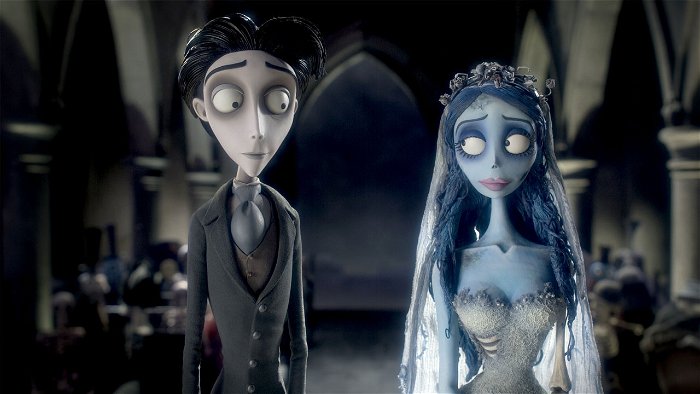
2005 turned out to be a very good year for Tim Burton as both Charlie and the Chocolate Factory and Corpse Bride were well received both critically and commercially. Corpse Bride was even given an Academy Award nomination for Best Animated Feature, which it eventually lost to another stop-motion effort, Wallace & Gromit: The Curse of the Were-Rabbit. Regardless of awards and accommodations, both films proved that Burton remains to this day a man of unique vision and box office clout; the outcast who felt no one understood him has risen above the pack to be favoured by movie fans from all over.
Part XI: The Future of Tim Burton
Tim Burton has built a career on his darkly whimsical directorial style, crafting unique visual worlds in films like Beetlejuice, Edward Scissorhands, and The Nightmare Before Christmas. Though his career has spanned over 30 years, Burton continues to develop new projects that showcase his signature aesthetic.
Burton’s most recent completed film was the live-action remake of Disney’s Dumbo in 2019, starring Colin Farrell, Michael Keaton, and Danny DeVito. The film received mixed reviews and modest box office returns. Prior to that, Burton directed the 2016 adaptation of Ransom Riggs’ novel Miss Peregrine’s Home for Peculiar Children. The fantasy film starred Eva Green and Asa Butterfield as peculiar children with special abilities.
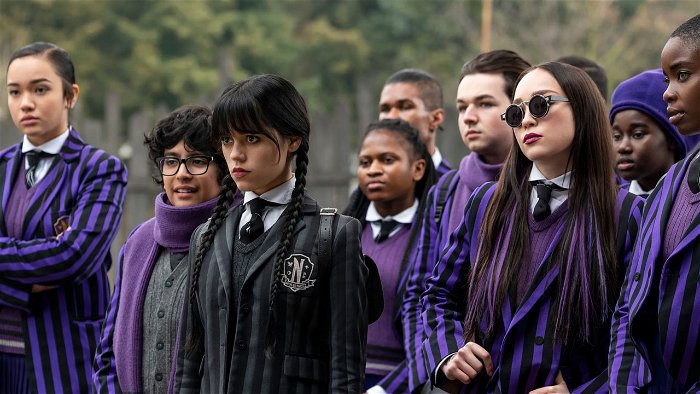
Currently, Burton is working on a sequel to one of his most beloved films, Beetlejuice. First announced in 1990, Beetlejuice 2 has faced development challenges. But it began filming in May 2023 but was subsequently put on hold due to the SAG-AFTRA strikes. Michael Keaton and Winona Ryder are reprising their roles from the 1988 original, joined by new cast members Jenna Ortega and Justin Theroux. The anticipated release date is September 2024.
Burton also recently made his first foray into television, directing four episodes of the Netflix series Wednesday. The show, based on The Addams Family character, stars Jenna Ortega as Wednesday Addams and premiered to strong reviews in late 2022. Burton’s influence was clear in the series’ macabre tone and aesthetic.
Though his Disney remake was not a success, Burton has stated he is unlikely to work with Disney again due to creative differences. However, the eagerly awaited Beetlejuice sequel shows Burton still has stories to tell within his signature bizarre, gothic style that resonates with audiences even after 30 years. Fans can expect more delightfully dark tales in the years to come.
Essential Works
- Tim Burton’s Corpse Bride (2005)
- Burton on Burton (2000)
- Sleepy Hollow (1999)
- The Melancholy Death of Oyster Boy and Other Stories (1997)
- Ed Wood (1994)
- The Nightmare Before Christmas (1993)
- Edward Scissorhands (1990)
- Batman (1989)
- Vincent and Frankenweenie (Included on the Special Edition DVD of The Nightmare Before Christmas)
